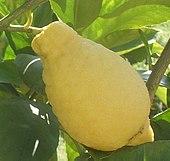
Sweet lemon and sweet lime refer to a diverse groups of citrus hybrids that contain low acid pulp and juice. They are hybrids often similar to non-sweet lemons or limes, but with less citron parentage.[1] Sweet limes and lemons are not sharply separated:
The sweet lime, Citrus limettioides Tan. (syn. C. lumia Risso et Poit.), is often confused with the sweet lemon, C. limetta Tan., (q.v. under LEMON) which, in certain areas, is referred to as "sweet lime". In some of the literature, it is impossible to tell which fruit is under discussion.[2]
The same plant may also be known by different names:
The Indian sweet lime is the mitha nimbu (numerous modifications and other local names) of India, the limûn helou or succari of Egypt, and the Palestine sweet lime (to distinguish it from the Millsweet and Tunisian limettas, commonly called sweet limes).[3]
The sweet lemons and sweet limes are not derived from either lemons or the more common limes, nor do they represent a monophyletic grouping, having arisen from distinct citrus hybridizations.[4] Plants and fruits with the common name sweet lemon or sweet lime include:
- Citrus limetta, small and round like a common lime, with sweet juice, a citron/sour orange hybrid.[4]
- Lumia, a large dry citron-like fruit that is pear shaped and not necessarily sweet. This is itself a mixed group: one member has been found to have resulted from a lemon crossing with a citron/pomelo hybrid,[5] a second member is a micrantha/citron mix.[4]
- Palestinian sweet lime, Citrus × latifolia, mainly used as a rootstock, a citron/mandarin/pomelo hybrid.[4]
- Ujukitsu, Citrus ujukitsu, or 'lemonade fruit', likely a tangelo, a Kishu mikan crossed with a pomelo-like fruit,[6] produced by citrus pioneer Chōzaburō Tanaka.
See also
- Citrus taxonomy
References
- ^ Gulson, O.; Roose, M. L. (2001). "Lemons: Diversity and Relationships with Selected Citrus Genotypes as Measured with Nuclear Genome Markers" (PDF). Journal of the American Society for Horticultural Science. 126 (3): 309–317. doi:10.21273/JASHS.126.3.309.
- ^ Morton, Julia F. (1987). "Sweet Lime". Fruits of Warm Climates. Florida Flair Books. pp. 175–176.
- ^ Hodgson, Robert Willard (1967). Reuther, W.; Webber, H. J.; Batchelor, L. D. (eds.). "Horticultural Varieties of Citrus". The Citrus Industry. University of California, Berkeley. I: 431–459.
- ^ a b c d Curk, Franck; Ollitrault, Frédérique; Garcia-Lor, Andres; Luro, François; Navarro, Luis; Ollitrault, Patrick (2016). "Phylogenetic origin of limes and lemons revealed by cytoplasmic and nuclear markers". Annals of Botany. 11 (4): 565–583. doi:10.1093/aob/mcw005. PMC 4817432. PMID 26944784.
- ^ Garcia-Lor, Andres; Curk, Franck; Snoussi-Trifa, Hager; Morillon, Raphael; Ancillo, Gema; Luro, François; Navarro, Luis; Ollitrault, Patrick (2011). "A nuclear phylogenetic analysis: SNPs, indels and SSRs deliver new insights into the relationships in the 'true citrus fruit trees' group (Citrinae, Rutaceae) and the origin of cultivated species". Annals of Botany. 111 (1): 1–19. doi:10.1093/aob/mcs227. PMC 3523644. PMID 23104641.
- ^ Shimizu, Tokurou; Kitajima, Akira; Nonaka, Keisuke; Yoshioka, Terutaka; Ohta, Satoshi; Goto, Shingo; Toyoda, Atsushi; Fujiyama, Asao; Mochizuki, Takako; Nagasaki, Hideki; Kaminuma, Eli; Nakamura, Yasukazu (2016). "Hybrid Origins of Citrus Varieties Inferred from DNA Marker Analysis of Nuclear and Organelle Genomes". PLOS ONE. 11 (11): e0166969. doi:10.1371/journal.pone.0166969. PMC 5130255. PMID 27902727.
_Mosambi_at_a_market_in_Seethammadhara.jpg)
